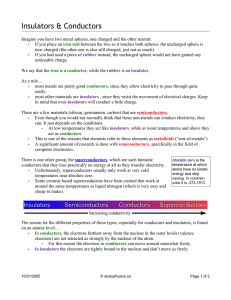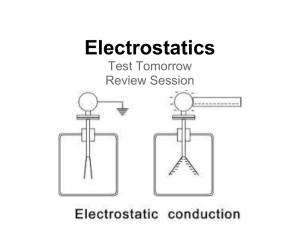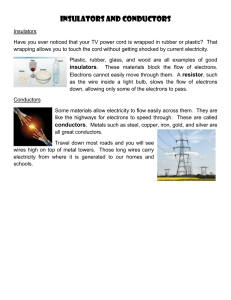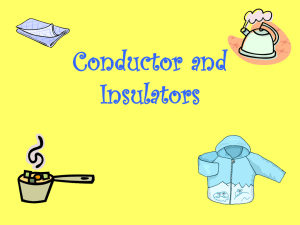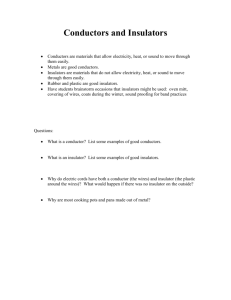Lesson 7: Insulators, Conductors, and the Others
advertisement
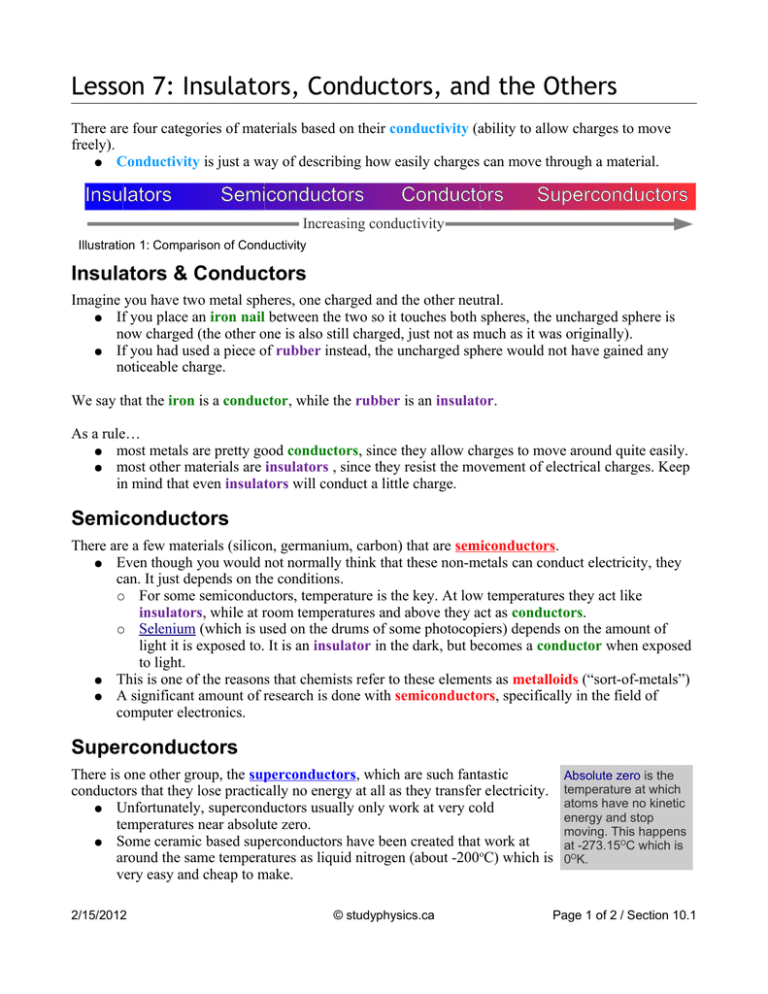
Lesson 7: Insulators, Conductors, and the Others There are four categories of materials based on their conductivity (ability to allow charges to move freely). ● Conductivity is just a way of describing how easily charges can move through a material. Insulators Semiconductors Conductors Superconductors Increasing conductivity Illustration 1: Comparison of Conductivity Insulators & Conductors Imagine you have two metal spheres, one charged and the other neutral. ● If you place an iron nail between the two so it touches both spheres, the uncharged sphere is now charged (the other one is also still charged, just not as much as it was originally). ● If you had used a piece of rubber instead, the uncharged sphere would not have gained any noticeable charge. We say that the iron is a conductor, while the rubber is an insulator. As a rule… ● most metals are pretty good conductors, since they allow charges to move around quite easily. ● most other materials are insulators , since they resist the movement of electrical charges. Keep in mind that even insulators will conduct a little charge. Semiconductors There are a few materials (silicon, germanium, carbon) that are semiconductors. ● Even though you would not normally think that these non-metals can conduct electricity, they can. It just depends on the conditions. ○ For some semiconductors, temperature is the key. At low temperatures they act like insulators, while at room temperatures and above they act as conductors. ○ Selenium (which is used on the drums of some photocopiers) depends on the amount of light it is exposed to. It is an insulator in the dark, but becomes a conductor when exposed to light. ● This is one of the reasons that chemists refer to these elements as metalloids (“sort-of-metals”) ● A significant amount of research is done with semiconductors, specifically in the field of computer electronics. Superconductors There is one other group, the superconductors, which are such fantastic conductors that they lose practically no energy at all as they transfer electricity. ● Unfortunately, superconductors usually only work at very cold temperatures near absolute zero. ● Some ceramic based superconductors have been created that work at around the same temperatures as liquid nitrogen (about -200oC) which is very easy and cheap to make. 2/15/2012 © studyphysics.ca Absolute zero is the temperature at which atoms have no kinetic energy and stop moving. This happens at -273.15OC which is 0OK. Page 1 of 2 / Section 10.1 Reasons for Different Conductivity The reason for the different properties of these types, especially for conductors and insulators, is found on an atomic level… ● In conductors, the electrons furthest away from the nucleus in the outer levels (valence electrons) are not attracted as strongly by the nucleus of the atom. ○ For this reason the electrons in conductors can move around somewhat freely. ● In insulators the electrons are tightly bound to the nucleus and don’t move as freely. When a charged object is brought close to a conductor, the free electrons in the conductor will move either away or towards the object depending on the charge of the other object. ● Remember that like charges repel, unlike attract. ● In this example, a positively charged object is brought near a neutral conductor. +++++++ +++++++ ----- +++ +++ Illustration 2: Separation of charge caused by a positively charged object. ● ● ● The electrons in the neutral object have shifted to the left since they are attracted towards the positive object. Always remember that in any situation, only electrons can move! The protons are “trapped” in the nucleus and can't move around. That means the protons remain on the right. This is referred to as a separation of charge. There are still equal numbers of negative and positive charges that cancel each other out, but they are separate from each other. If a negatively charged object is brought close to a conductor… + + + + + + Illustration 3: Separation of charge caused by a negative object The negative charges in the conductor will pile up as far away from the object as possible. The positive charges remaining on the left side make it positive. Again, this is a separation of charge. In a semiconductor, there are only a few electrons that can freely move around, and in an insulator almost none. ● If you bring a charged object near one of these, you won’t see this separation of charge happen. ● ● ● Homework p.523 #4 2/15/2012 © studyphysics.ca Page 2 of 2 / Section 10.1
